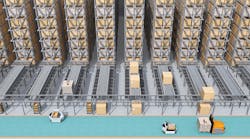Six Reasons Not to Let Economic Uncertainty Pause Your Automation Investment
Change, as we know, is constant. Today though, demand fluctuation, labor uncertainty and unforeseen disruption batter warehouse operations relentlessly. Navigating the uncertainty of today’s operations with a focus on the short horizon might seem like a good way to go, but it can make it difficult to think strategically about return on investments—even those that might be able to smooth some of the bumps in the road.
Supply chain leaders in warehouse operations are aware of the conflict between getting through the next day, month or quarter—and the need to look at the long game. In 2022, a Warehouse Vision Study found that nearly 85% of respondents plan to rely more on automation in the future. At the same time, more than 60% said they do not know where to start. There are many reasons for this gap. Even though supply chain leaders are quick to recognize that technology can help reduce the labor uncertainty, many may still be reluctant to pursue automation because they believe these projects are risky, costly and complicated.
Risk-averse for good reason, supply chain leaders may be reluctant to test out a new technology that may disrupt operations. Given the ongoing uncertainty of the global economy, many believe that now is not the time to experiment. But today’s ever-present state of uncertainty is exactly why those whose job it is to keep supply chains moving should look at ways to streamline and optimize workflows, information flows and decision-making throughout their operations.
Here are six reasons why taking a bold step toward innovation with today’s advanced automation is the right one now.
1. You are not going to find the people you need to get the job done.
Labor shortages are real, and they are not going to get any less real. Research shows that less than 3% of the Gen-Z demographic is interested in working in logistics; instead, they’re looking at STEM-related fields. The interest in working in environments where technology is essential to the day-to-day resonates with today’s workforce as well. In the afore-mentioned Warehouse Vision Study, more than 80% of associates shared that that they are more likely to work for an employer that gives them modern devices—like handheld tablets, robots and wearables with augmented reality apps—to use on the job. Today’s automation, and the technology it brings to the operation, is a powerful way to both retain and attract workers.
2. The perception of automation projects as large-scale, expensive and requiring long consulting engagements in order to automate a single task is simply no longer true.
Today’s automation solutions for material movement:
• are cost-accessible for operations of all sizes;
• can be deployed in less than a month;
• do not require massive infrastructure reconfiguration or additional investments like safety cages;
• can be configured to do multiple tasks without the need of robotics engineers;
• and include advanced software that accelerates the design and definition of workflows that incorporate the robot, devices, equipment and environment so it is easy to set up and modify them as processes evolve or needs change.
3. Robot-as-a-service (RaaS) subscription models eliminate the need for capital expenditure to get the technology in place and make rapid deployments more feasible.
In addition, the cloud-based architectures of RaaS and SaaS automation solutions allow for remote management by in-house or third-party solution providers. Automated mobile robots (AMRs), for example, can be physically unboxed by warehouse or factory managers and configured by a remote workflow manager using a cloud dashboard and simple programming tools. With this model, customers take delivery of the robot, work with an implementation team on configuring the robot to perform the tasks necessary, and pay a monthly subscription fee for the use of the robot.
When upgrades are offered, the customer receives them at no cost, and maintenance is part of the subscription.
4. Robots today are more brain than brawn.
Software is the key to making today’s robots the engine for operational transformation they are quickly becoming. In the warehouse, data that can answer questions like which robot is carrying which order, how many items and orders are assigned to that robot, what is the best route for the robot to take to fully execute the order—from pick to pack to ship—are critical to quickly and efficiently completing orders. It is software that analyzes myriad variables and makes the optimal choices that need to be made in order for the operation to perform as it must.
5. Fixed automation, like conveyor lines, can only take you so far.
Waytek, a Minnesota-based electronics distributor, found that its fixed conveyor system made expanding capacity to meet rising demand a daunting challenge. With AMRs on the job, Waytek was able to capture a 25% increase in throughput, reclaim 13% of floor space, and automate manual tasks—including replenishment and dunnage—to free people from tedious tasks.
6. Incremental progress adds up quickly to sustained success.
With flexible automation like AMRs, you can start small and build on the success you achieve. The days of long, drawn-out pilots are well over. In fact, the best way to get started is to look around your operation and identify tasks that are done by people where the uniquely human abilities are not being applied. And start there.
It may be unloading and relocating inbound inventory to where it is needed, or taking a tote with an order to be packed and shipped, or delivering a returned item to the location where it can be re-picked and shipped to a customer who is waiting for it. Once the productivity improvements are achieved, move on to the next workflow and watch the skeptics come around.
There’s No Room for Procrastination
The fundamentals have changed for material movement in ways that no one could have predicted five years ago. The shift centers on the strategic role that material handling and movement now play in supply chain, and there’s no going back.
Agility and responsiveness are fast becoming key differentiators for warehouse operations, especially those in consumer-facing sectors. In the day-to-day, it can be hard to lose sight of the long game, but warehouse operations have to perform in a world that is more dynamic than ever, with more change always on the horizon. This reality is why it is essential to think strategically about the ways in which automation, for example, can meet consumers’ ever-rising expectations for choice, cost and delivery options or how to design inbound and outbound operations to scale up and down in response to disruption and uncertainty.
Flexible automation solutions deliver the holistic solutions needed today and deliver speed, accuracy and volume—not just at the task level, but across entire workflows. It is by recognizing the interdependency of each step with another, and just how important it is to make the actions both within and between seamless and smooth, that operations advance and performance is optimized.
James Lawton is vice president and general manager, robotics automation, with Zebra Technologies, a digital solution provider enabling businesses to intelligently connect data, assets and people.



